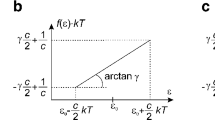Summary
A numerical algorithm (HILDA) is developed and made available for the determination of the surface heterogeneity 'of a powder sample in terms of a ‘patchwise’ adsorptive energy distribution function. Adsorption on unisorptic `patches' may be described by a choice of model isotherm functions. These are the Hill-de Boer equation, Fowler-Guggenheim, Langmuir and the two dimensional virial equation. Parameters are presented to enable HILDA to be applied to a variety of adsorption systems. It is demonstrated how the monolayer capacity of a surface can be determined and the results are compared to BET values. HILDA is also used to follow the changes in the adsorptive energy distribution that occur with annealing a high specific area sodium chloride sample. It is concluded that the method has considerable potential for future applications.
Zusammenfassung
Es wurde ein numerischer Algorithmus (HILDA) entwickelt und zugänglich gemacht, um die Oberflächenheterogenität eines Pulverpräparates in Termen einer “fleckenweisen” Adsorptionsenergieverteilungsfunktion zu bestimmen. Die Adsorption an einheitlich adsorbierenden “Flecken” kann durch die Wahl geeigneter Modellisothermen beschrieben werden. Als solche dienen die Gleichungen nach Hill-de Boer, Fowler-Guggenheim, Langmuir sowie die zweidimensionale Virialgleichung. Es werden Parameter angegeben, mit deren Hilfe HILDA auf eine Vielzahl von Adsorptionssystemen angewendet werden kann, und es wird gezeigt, wie die Monoschichtkapazität einer Oberfläche bestimmt werden kann.
Die Ergebnisse werden mit BET-Werten verglichen. HILDA wird weiterhin verwendet, um Änderungen in der Verteilung der Adsorptionsenergie zu verfolgen, welche beim Tempern eines Kochsalzpräparates mit hoher spezifischer Oberfläche erfolgen.
Similar content being viewed by others
References
Young, D. M.,A. D. Crowell, Physical Adsorption of Gases (London 1962).
Ross, S.,J. P. Olivier, On Physical Adsorption (New York 1964).
Gregg, S. J., K. S. W. Sing, Adsorption, Surface Area and Porosity (London 1967).
Steele, W. A., The Interaction of Gases with Solid Surfaces, The International Encyclopedia of Physical Chemistry and Chemical Physics (Oxford 1974).
House, W. A., M. J. Jaycock, Proc. Royal Soc. A.348, 317 (1976).
Hoory, S., J. M. Prausnitz, Surface Sci.6, 377 (1967).
House, W. A., Ph. D. Thesis, Loughborough University of Technology, p. 161 (1975).
Fowler, R., E. A. Guggenheim, Statistical Thermodynamics, Chap. 8 (Cambridge 1939).
Morrison, I. D., S. Ross, Surface Sci.39, 21 (1973).
Hildebrand, F. B., Introduction to Numerical Analysis, 295 (London 1956).
Adamson, A. W., I. Ling, Advan. Chem. Ser., No. 33, 51 (1961).
Hamming, R. W., Numerical Methods for Scientists and Engineers, 349 (London 1973).
Clenshaw, C. W., A. R. Curtis, Numerische Mathematik7, 406 (1965).
Ross, S., I. D. Morrison, Surface Sci.52, 103 (1975).
Waldsax, J. C. R., Ph. D. Thesis, Loughborough University of Technology, p. 71 (1970).
House, W. A., M. J. Jaycock, J. Colloid Interf. Sci. In press.
Author information
Authors and Affiliations
Additional information
With 6 figures and 4 tables
Rights and permissions
About this article
Cite this article
House, W.A., Jaycock, M.J. A numerical algorithm for the determination of the adsorptive energy distribution function from isotherm data. Colloid & Polymer Sci 256, 52–61 (1978). https://doi.org/10.1007/BF01746691
Received:
Issue Date:
DOI: https://doi.org/10.1007/BF01746691




